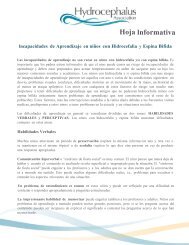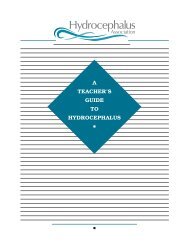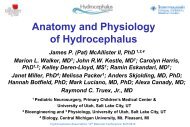Fact Sheet: Cerebrospinal Fluid Shunt Systems for the Management ...
Fact Sheet: Cerebrospinal Fluid Shunt Systems for the Management ...
Fact Sheet: Cerebrospinal Fluid Shunt Systems for the Management ...
Create successful ePaper yourself
Turn your PDF publications into a flip-book with our unique Google optimized e-Paper software.
Types of Differential Pressure (DP) Valves<br />
Slit valves. These valves, made of curved, silicone rubber material, are characterized by a cut,<br />
or slit. Flow on <strong>the</strong> concave side of <strong>the</strong> valve, if sufficient, will open <strong>the</strong> slit. The hydrodynamic<br />
properties of <strong>the</strong> valve depend on <strong>the</strong> thickness and stiffness of <strong>the</strong> elastomer and <strong>the</strong> number of<br />
slits. Some slit valves incorporate an internal spring to prevent slit inversion, which would lead to<br />
reflux (backward flow). These valves’ operating characteristics depend on slit integrity. The aging<br />
of silicone rubber materials and mishandling during surgery may significantly alter <strong>the</strong> per<strong>for</strong>mance<br />
of slit valves. The Codman Holter Valve, <strong>the</strong> Uni-shunt, <strong>the</strong> Phoenix Diamond, <strong>the</strong> Cruci<strong>for</strong>m,<br />
and <strong>the</strong> CRx are all slit valves.<br />
Duck-bill and miter valves. These valves are characterized by a round orifice that converges into<br />
two flat, horizontally opposed leaflets made of silicone. The valve leaflets open when <strong>the</strong> DP<br />
across <strong>the</strong>m increases. These valves operating characteristics depend on <strong>the</strong> size, shape, thickness,<br />
and length of <strong>the</strong> leaflets. The Integra Lifesciences (Heyer-Schulte) Mischler Valve is a miter valve.<br />
Spring-loaded, ball-in-cone valves. These valves incorporate a metallic coiled or flat spring that<br />
applies a calibrated <strong>for</strong>ce to a ball manufactured from a syn<strong>the</strong>tic ruby, located in a cone-shaped<br />
orifice. Such valves’ opening pressure is defined by <strong>the</strong> properties of <strong>the</strong> spring. The size of <strong>the</strong><br />
valve module opening changes according to DP across <strong>the</strong> mechanism: <strong>the</strong> higher <strong>the</strong> pressure<br />
differential, <strong>the</strong> larger <strong>the</strong> size of <strong>the</strong> opening. The ball moves away from <strong>the</strong> seat as DP increases,<br />
under control of <strong>the</strong> spring, <strong>the</strong>reby increasing <strong>the</strong> cross-sectional area through which CSF flows.<br />
When DP across <strong>the</strong> valve decreases, <strong>the</strong> ball moves toward <strong>the</strong> seat, reducing <strong>the</strong> cross-sectional<br />
area through which CSF flows.<br />
NMT Neuroscience produces a gravity-compensating lumboperitoneal valve (<strong>the</strong> HV Lumbar<br />
Valve) and a separate Gravity-Compensating Accessory that add resistance when an individual<br />
stands through <strong>the</strong> weight of several stainless steel balls on a ball-in-cone mechanism. Flow is not<br />
restricted when an individual is lying down.<br />
Ball-in-cone valves are less prone to <strong>the</strong> effects of <strong>the</strong> aging of materials than are miter or slit<br />
valves, and <strong>the</strong>y have been demonstrated to handle higher CSF protein levels. Examples of ball-incone<br />
valves include <strong>the</strong> Hakim Valve, available from NMT Neuroscience and Codman, a Johnson &<br />
Johnson Company, and <strong>the</strong> Phoenix Accura valves, available from Phoenix Biomedical Corp.<br />
Diaphragm valves. In <strong>the</strong>se valves, a mobile flexible membrane moves in response to pressure<br />
differences. The membrane may be held by a central piston that moves in a sleeve, or it may surround<br />
<strong>the</strong> piston and act as an occluder. The membrane can also be a dome that de<strong>for</strong>ms under<br />
pressure. These valves’ operating characteristics are based on <strong>the</strong> stiffness of <strong>the</strong> silicone rubber<br />
diaphragm, which is mounted beneath an integral pumping reservoir and has no metal parts.<br />
Pressure differentials cause <strong>the</strong> diaphragm to move, allowing CSF to flow around it. When pressure<br />
abates, <strong>the</strong> diaphragm seals <strong>the</strong> mechanism. The Radionics Contour Flex Valve and <strong>the</strong><br />
Medtronic PS Medical Delta Valve are examples of pressure-regulated diaphragm valves.<br />
Some DP valves include integral Anti-Siphon Devices (ASD) or Siphon Control Devices (SCD).<br />
Examples include <strong>the</strong> Medtronic PS Delta and <strong>the</strong> Integra Lifesciences Novus valves. Although<br />
Hydrocephalus Association • 1-888-598-3789 • www.hydroassoc.org
















